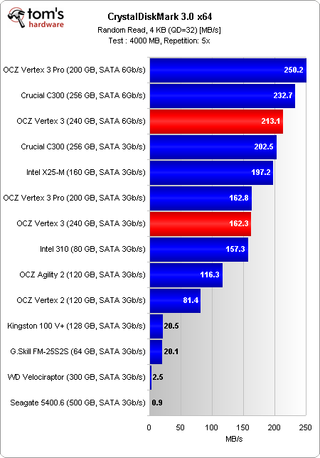Benchmark Results: 4 KB And 512 KB Random Reads



The header of these two charts is the same, except for one important detail. The first employs a queue depth of one, and the second uses a queue depth of 32. Why are these figures important? Well, look what they do to performance.
Native Command Queuing, part of the SATA specification, was originally designed to improve the performance of mechanical disks by allowing the hard drive itself to optimize the order in which read and write commands get executed. Of course, the physics of a hard drive don’t apply to SSDs. However, the multi-channel architecture of a solid state drive enables it to similarly field multiple concurrent requests—though Intel claims the bottleneck isn’t the drive, but rather the host system itself. Today’s SSDs are consequently dependent on high queue depths in order to realize the specifications you see manufacturers quoting.
With a QD of one, the Vertex 3 isn't quite as impressive as the Pro model, but this is to be expected. The gap widens with more concurrent requests applied to each drive. Fortunately, while they're plausible for the enterprise space, high queue depths are unrealistic on the desktop. Compared to the previous generation, though, the Vertex 3 shows a marked improvement. We are looking at nearly 215 MB/s to the Vertex 2's 81.2 MB/s.

Stay on the Cutting Edge
Join the experts who read Tom's Hardware for the inside track on enthusiast PC tech news — and have for over 25 years. We'll send breaking news and in-depth reviews of CPUs, GPUs, AI, maker hardware and more straight to your inbox.
Current page: Benchmark Results: 4 KB And 512 KB Random Reads
Prev Page Benchmark Results: CrystalDiskMark Streaming Performance Next Page Benchmark Results: 4 KB And 512 KB Random WritesMost Popular

